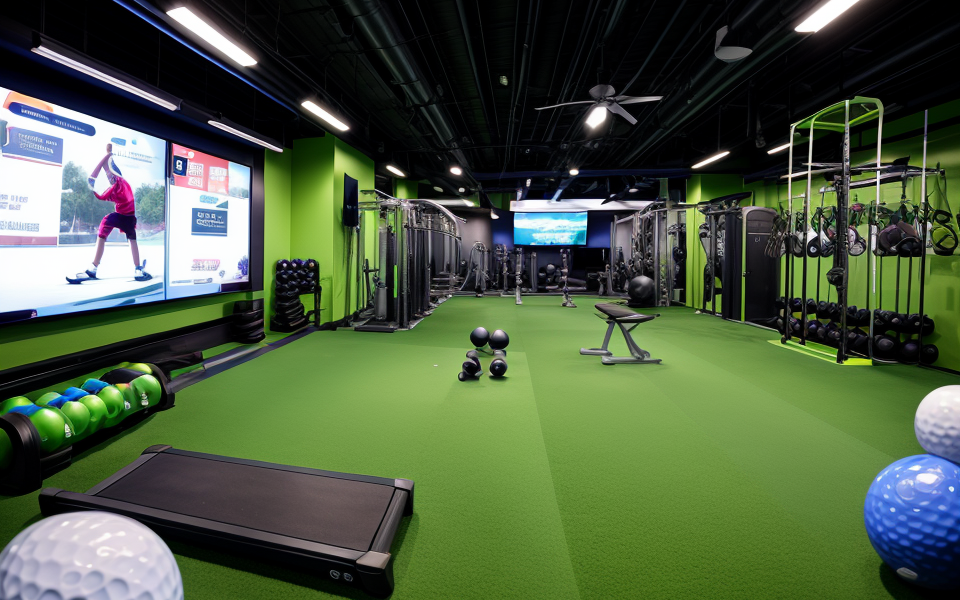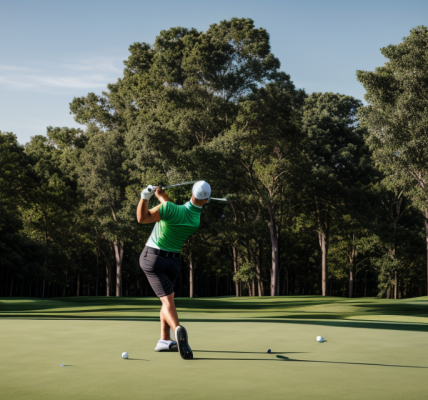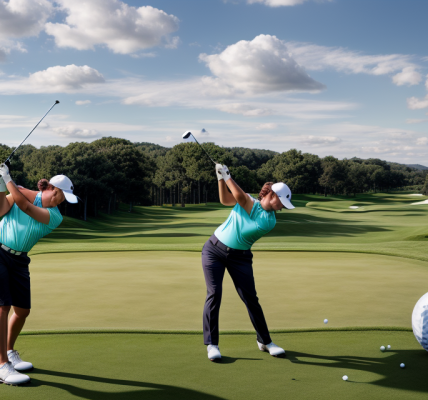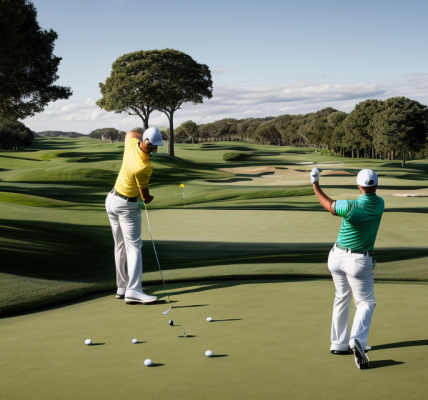If you’re a golfer looking to improve your game, you might be surprised to learn that you can practice golf at the gym! While traditional golf practice involves hitting balls on the driving range or playing rounds on the course, there are many exercises and equipment that can help you improve your swing, strength, and overall golf performance. In this guide, we’ll explore some of the best ways to practice golf at the gym, from resistance bands to golf-specific machines. Whether you’re a beginner or an experienced golfer, there’s something here for everyone. So grab your gym bag, put on your golf shoes, and let’s get started on the path to improved golf performance!
Warming Up
Importance of Warming Up
- Preventing injuries
- Warming up before practicing golf at the gym is crucial to prevent injuries. When the muscles are warmed up, they become more flexible and less prone to tearing or straining.
- It is essential to perform dynamic stretches that target the muscles used in golf, such as the legs, hips, and shoulders, to increase blood flow and reduce the risk of injury.
- Improving performance
- Warming up before practicing golf at the gym can also improve performance by increasing muscle temperature and preparing the body for physical activity.
- This can lead to better coordination, faster reaction times, and more efficient energy expenditure during the golf practice session.
- Warming up can also increase the efficiency of the cardiovascular system, allowing for better endurance and stamina during the practice session.
- Incorporating light cardiovascular exercises, such as jogging or cycling, into the warm-up routine can help improve overall fitness and enhance golf performance.
Effective Warm-Up Exercises
Before getting into any physical activity, warming up is essential to prevent injury and improve performance. When it comes to practicing golf at the gym, a proper warm-up routine can help you prepare your body for the physical demands of the game. Here are some effective warm-up exercises that you can incorporate into your routine:
Light Cardio
Start your warm-up routine with light cardio exercises to get your heart rate up and increase blood flow to your muscles. Examples of light cardio exercises include jogging, cycling, or rowing at a low intensity for 5-10 minutes. This will help you increase your body temperature and get your muscles ready for the workout ahead.
Dynamic Stretching
Dynamic stretching involves moving stretches that help increase range of motion and improve flexibility. These stretches are perfect for warming up before a workout as they help to prepare your muscles for physical activity. Examples of dynamic stretches include leg swings, arm circles, and hip openers.
Mobility Exercises
Mobility exercises are designed to improve the range of motion in your joints and help you move better. These exercises are especially important for golfers as they require a full range of motion in their shoulders, hips, and back. Examples of mobility exercises include squats, lunges, and hip flexor stretches.
Incorporating these warm-up exercises into your routine can help you prepare your body for a successful golf practice session. Remember to listen to your body and adjust your warm-up routine as needed to ensure that you are adequately preparing yourself for physical activity.
Building Strength and Endurance
Resistance Training
- Dumbbell exercises
- Kettlebell exercises
- Medicine ball exercises
Resistance training is a crucial aspect of building strength and endurance for golf. It involves using weights or resistance bands to challenge your muscles and help them grow stronger. There are many different exercises that can be done with dumbbells, kettlebells, and medicine balls to target the muscles used in golf.
Dumbbell Exercises
Dumbbell exercises are a great way to build strength and muscle endurance. Some of the best exercises for golf include:
- Bicep curls: This exercise targets the biceps, which are important for swinging the club.
- Tricep dips: The triceps are also crucial for the golf swing, and tricep dips are an effective exercise for building strength in this muscle group.
- Shoulder press: The shoulder press works the shoulders, which are important for the power behind the swing.
- Squats: Squats are a compound exercise that work the legs, glutes, and core, all of which are important for balance and stability in the golf swing.
Kettlebell Exercises
Kettlebell exercises are another great option for building strength and endurance for golf. Some of the best exercises include:
- Swings: Kettlebell swings work the entire body, including the legs, glutes, back, and core. They are a great exercise for building overall strength and power.
- Goblet squats: This exercise targets the legs, glutes, and core, making it a great choice for improving balance and stability in the golf swing.
- Russian twists: Russian twists work the obliques, which are important for maintaining proper posture and balance during the swing.
Medicine Ball Exercises
Medicine ball exercises are a versatile option for building strength and endurance for golf. Some of the best exercises include:
- Plank with medicine ball push-ups: This exercise works the chest, shoulders, and triceps, as well as the core for stability.
- Medicine ball slams: This exercise works the entire body, including the legs, glutes, back, and core, making it a great choice for building overall strength and power.
- Medicine ball side plank: This exercise works the obliques, which are important for maintaining proper posture and balance during the swing.
Overall, resistance training is a crucial aspect of building strength and endurance for golf. By incorporating dumbbell, kettlebell, and medicine ball exercises into your workout routine, you can improve your muscle strength and endurance, leading to better performance on the golf course.
Cardiovascular Training
Cardiovascular training is a crucial aspect of golf fitness as it helps to improve endurance, reduce recovery time, and enhance overall physical fitness. Here are some cardiovascular exercises that golfers can incorporate into their workout routine:
- High-intensity interval training (HIIT): HIIT is a form of cardiovascular training that involves short bursts of intense exercise followed by periods of rest or active recovery. Golfers can perform HIIT workouts by doing sprints, hill sprints, or jump rope drills. These exercises are effective in improving endurance, speed, and power, which are essential for success on the golf course.
- Endurance training: Endurance training involves longer periods of sustained physical activity, such as jogging, cycling, or swimming. Golfers can benefit from endurance training by improving their cardiovascular endurance, which will help them to play more holes without getting tired. Additionally, endurance training can help to reduce the risk of injury and improve overall physical fitness.
- Golf-specific drills: Golf-specific drills are exercises that simulate the physical demands of golf, such as swinging a club, walking on uneven terrain, and carrying a golf bag. These drills can help golfers to improve their endurance, strength, and flexibility, while also reducing the risk of injury. Examples of golf-specific drills include walking lunges, band walks, and balance exercises.
It is important to note that cardiovascular training should be combined with strength training and flexibility exercises to achieve optimal results. Golfers should consult with a fitness professional or certified personal trainer to develop a comprehensive workout program that addresses their individual needs and goals.
Improving Flexibility and Mobility
Flexibility Exercises
Incorporating flexibility exercises into your workout routine is essential for improving your range of motion and reducing the risk of injury. Here are some exercises that you can try:
- Static stretching: This involves holding a stretch for a period of time to improve flexibility. To stretch your hamstrings, sit on the floor with your legs extended in front of you and reach towards your toes. Hold the stretch for 15-30 seconds and repeat several times.
- Yoga: Yoga is a great way to improve flexibility and balance. Try incorporating poses such as downward facing dog, child’s pose, and pigeon pose into your routine.
- Pilates: Pilates is a form of exercise that focuses on core strength and flexibility. Try incorporating exercises such as the Hundred, the Single Leg Stretch, and the Roll-Up into your routine.
Remember to stretch before and after your workout to prevent injury and improve flexibility. Be sure to listen to your body and avoid pushing yourself too hard, as this can lead to injury.
Mobility Exercises
When it comes to improving flexibility and mobility for golf, there are several exercises that can be done at the gym. These exercises are designed to improve the range of motion in the joints and increase strength in the muscles that support the golf swing.
Dynamic stretching is a type of stretching that involves moving the body through a full range of motion, rather than holding a static stretch. This type of stretching is ideal for golfers because it can help improve the ability to move in all directions, which is crucial for a smooth and powerful golf swing.
One example of dynamic stretching that can be done at the gym is leg swings. To perform this exercise, stand with your feet hip-width apart and swing one leg forward and backward, keeping it straight. Perform 10-15 repetitions on each leg.
Balance exercises
Balance exercises are also important for golfers because they help improve stability and control during the swing. One balance exercise that can be done at the gym is single-leg squats. To perform this exercise, stand with one foot on a stability ball and lower your body into a squat, keeping your knees aligned with your toes. Perform 10-15 repetitions on each leg.
Functional movements
Functional movements are exercises that target the muscles used in the golf swing. One example of a functional movement that can be done at the gym is the deadlift. To perform this exercise, stand with your feet hip-width apart and bend your knees slightly. Hold a barbell with your hands shoulder-width apart and lift it up from the ground, keeping your back straight. Lower the barbell back down to the ground and repeat for 10-15 repetitions.
Incorporating these mobility exercises into your gym routine can help improve your flexibility and mobility on the golf course. It’s important to remember that these exercises should be done with proper form and under the guidance of a trained professional, to avoid injury.
Enhancing Coordination and Balance
Coordination Exercises
Balance Training
Balance training is a crucial aspect of golf practice, as it helps to improve stability and prevent falls during swings. Some balance exercises that can be done at the gym include single-leg standing, single-leg squats, and single-arm balances. These exercises can be modified to suit different fitness levels and can be incorporated into a warm-up routine before golf practice.
Agility Drills
Agility drills are designed to improve quick movements and reactions, which are essential for a successful golf swing. Some examples of agility drills include ladder drills, cone drills, and shuffle drills. These exercises can be performed with or without equipment and can be modified to suit different fitness levels.
Footwork Drills
Footwork drills are important for golfers, as they help to improve balance, stability, and power during swings. Some footwork drills that can be done at the gym include lateral shuffles, crossover steps, and pivot turns. These exercises can be modified to suit different fitness levels and can be incorporated into a warm-up routine before golf practice.
By incorporating coordination exercises into a regular gym routine, golfers can improve their balance, stability, and power, leading to better performance on the golf course.
Balance Exercises
Enhancing coordination and balance is essential for improving one’s golf swing. Golf swings require precise movements that demand stability and control over body movements. The following exercises can help golfers develop the necessary balance and coordination to improve their golf game.
Single-leg balance
Single-leg balance exercises are essential for golfers as they improve balance and stability on one leg, which is crucial during the golf swing. To perform this exercise, stand on one leg while balancing on the other leg’s toes. Keep your knees and toes pointing towards the ground. Maintain this position for as long as possible, aiming for at least 30 seconds. Switch legs and repeat the exercise.
Balance boards
Balance boards are another excellent tool for improving balance and coordination. These boards are designed to rock back and forth, and they challenge the body’s stabilizing muscles. Stand on the board with both feet and try to maintain your balance while it rocks back and forth. Start with a slower pace and gradually increase the speed. Hold onto a wall or chair for support if necessary.
Stability balls
Stability balls are a versatile tool that can be used to improve balance and coordination. Sit on the ball with your feet flat on the floor and your knees bent. Use your core muscles to maintain balance on the ball. Try to sit still for as long as possible, aiming for at least 30 seconds. Gradually increase the time as your balance and core strength improve.
By incorporating these balance exercises into their workout routine, golfers can improve their balance and coordination, which can lead to a more efficient and effective golf swing.
Functional Movements
Squats
Squats are a fundamental movement that are essential for golfers. They help in improving lower body strength, balance, and stability. There are different variations of squats that can be performed, such as front squats, back squats, and goblet squats. It is recommended to start with bodyweight squats and gradually increase the weight as you become more comfortable with the movement. Squats also help in improving hip mobility, which is crucial for a smooth golf swing.
Deadlifts
Deadlifts are another functional movement that can improve overall strength and power. They target the hamstrings, glutes, and lower back muscles, which are crucial for a stable and powerful golf swing. Deadlifts can be performed using a barbell or dumbbells, and it is important to maintain proper form and technique to avoid injury. It is recommended to start with lighter weights and gradually increase the load as you become more comfortable with the movement.
Lunges
Lunges are a unilateral exercise that targets the muscles in the legs, including the glutes, quads, and hamstrings. They help in improving balance, stability, and coordination, which are essential for a successful golf swing. There are different variations of lunges that can be performed, such as forward lunges, reverse lunges, and lateral lunges. It is recommended to start with bodyweight lunges and gradually increase the resistance as you become more comfortable with the movement. Lunges also help in improving mobility and flexibility in the hips and knees, which is crucial for a smooth and powerful golf swing.
Strengthening the Core
Importance of a Strong Core
Having a strong core is crucial for any golfer, as it plays a vital role in improving one’s swing, stability, and overall performance on the golf course. A strong core provides the following benefits:
- Stability: A stable core allows golfers to maintain balance and prevent twisting or swaying during their swing. This stability also helps in keeping the spine aligned and preventing injury.
- Power: A strong core generates power throughout the body, particularly in the hips and legs, which are essential for a powerful and accurate swing. A strong core also enables golfers to maintain control over their body throughout the swing, resulting in more consistent shots.
- Balance: A balanced core is essential for maintaining proper alignment and balance during the swing. Good balance ensures that the golfer can make solid contact with the ball and maintain control over the shot’s direction and trajectory. Additionally, a strong core helps in recovering quickly from an off-balance position, enabling golfers to maintain control even when hit by an unexpected gust of wind or an uneven lie.
Effective Core Exercises
Planks
Planks are a highly effective exercise for strengthening the core muscles, as they target the rectus abdominis, transverse abdominis, and the obliques. To perform a plank, start in a push-up position with your hands placed slightly wider than shoulder-width apart. Engage your core muscles and hold your body in a straight line from your head to your heels. Hold this position for 30 seconds to 1 minute, and repeat for 3-5 sets.
Russian twists
Russian twists are a great exercise for targeting the obliques, which are important for rotational power in golf swings. To perform Russian twists, lie on your back with your knees bent and feet flat on the floor. Hold a weight or medicine ball above your chest with both hands, and twist your torso to the right, touching the weight to the floor on the right side of your body. Return to the starting position and repeat on the left side. Perform 10-15 repetitions on each side.
Crunches
Crunches are a classic exercise for strengthening the core muscles, including the rectus abdominis and the obliques. To perform crunches, lie on your back with your knees bent and feet flat on the floor. Place your hands behind your head and lift your shoulders off the ground, curling your body up towards your knees. Pause at the top of the movement and then lower back down. Perform 10-15 repetitions.
These exercises can be modified to suit different fitness levels, and can be incorporated into a comprehensive fitness routine to improve overall athletic performance on the golf course.
Incorporating Golf-Specific Movements
Golf Swing Mechanics
When it comes to incorporating golf-specific movements into your gym routine, it’s important to understand the mechanics of the golf swing. The golf swing is a complex movement that involves several joints and muscles, and it’s essential to have a solid understanding of the mechanics in order to improve your swing and reduce the risk of injury.
Golf Swing Breakdown
The golf swing can be broken down into several phases: the backswing, the transition, and the downswing. During the backswing, the club is moved away from the body, and the arms and shoulders rotate. The transition phase is when the club moves from the backswing to the downswing, and the hips and torso rotate. During the downswing, the club is brought towards the ball, and the hands and wrists control the clubface.
Power and Control
Power and control are two important factors in the golf swing. Power is generated through the rotation of the hips and torso, while control is achieved through the hands and wrists. To generate power, it’s important to have a wide and stable base, as well as a strong core and legs. To improve control, it’s important to practice controlling the clubface and ball flight.
Kinetic Chain
The golf swing is a kinetic chain reaction, meaning that the movement of one body part affects the movement of the next. It’s important to have a solid understanding of the kinetic chain in order to improve your swing. The kinetic chain includes the feet, ankles, knees, hips, torso, shoulders, arms, and hands. Each of these body parts plays a crucial role in the golf swing, and it’s important to work on each one in order to improve your overall swing.
Golf-Specific Exercises
*Should
FAQs
1. Can I practice golf at the gym?
Yes, you can practice golf at the gym by using various gym equipment to simulate the golf swing and develop your muscles used in golf.
2. What equipment do I need to practice golf at the gym?
You can use gym equipment such as dumbbells, resistance bands, and medicine balls to practice your golf swing and work on your muscles used in golf. You may also use gym machines such as the elliptical machine or stationary bike to simulate the golf swing and improve your cardiovascular fitness.
3. How can I simulate the golf swing using gym equipment?
You can simulate the golf swing by holding light dumbbells or resistance bands and performing the motion of a golf swing. You can also use medicine balls to practice your balance and stability during the swing. It’s important to focus on your form and technique to ensure that you are properly developing the muscles used in golf.
4. Are there any specific exercises I can do to improve my golf game?
Yes, there are many exercises that can help improve your golf game. For example, exercises that target your core, shoulders, and upper back can help improve your swing and stability. Exercises such as planks, Russian twists, and rows can be especially beneficial for golfers.
5. Can practicing golf at the gym improve my overall fitness?
Yes, practicing golf at the gym can improve your overall fitness by working on your muscles used in golf and improving your cardiovascular fitness through exercises such as using the elliptical machine or stationary bike. In addition, golf-specific exercises can help improve your balance, stability, and flexibility, which can benefit your overall fitness and performance on the golf course.




